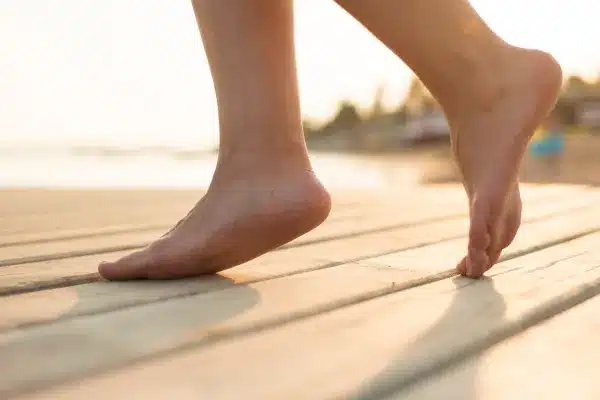Flat feet, also known as pes planus, is a condition where the arches of the feet collapse, causing the entire sole of the foot to touch the ground. While flat feet are common, many people don’t realize how this condition can lead to more serious foot problems down the road. Flat arches can contribute to a range of foot deformities, including bunions, hammertoes, and other painful conditions that can affect mobility and quality of life.
In this post, we’ll explore the connection between flat feet and various foot deformities, explaining how the misalignment caused by flat arches can set the stage for other issues.
How Flat Feet Lead to Foot Deformities
The arches of our feet act as shock absorbers, providing support and distributing weight evenly across the foot while we walk or run. When these arches collapse, the mechanics of the foot change, leading to abnormal stress and pressure on the joints and tendons. Over time, this imbalance can cause misalignment and the development of several foot deformities.
Here’s how flat feet can lead to specific foot problems:
1. Bunions (Hallux Valgus)
Bunions are one of the most common foot deformities caused by flat feet. When the arches fall, the big toe may begin to drift toward the second toe, creating a bony bump on the side of the foot. This misalignment of the toe joint puts increased pressure on the big toe, which can lead to pain, swelling, and the formation of a bunion.
Flat feet contribute to bunion formation by:
- Increasing the inward rotation of the foot, which causes the big toe to shift toward the second toe.
- Altering the biomechanics of walking, which places extra strain on the joint at the base of the big toe.
- Causing instability in the foot that accelerates the development of the deformity.
2. Hammertoes
Hammertoes occur when one or more of the toes become bent at the middle joint, resembling a hammer. This can lead to pain, difficulty in finding shoes that fit, and issues with walking. Flat feet can lead to hammertoes by affecting the muscles and tendons that control toe movement.
Here’s how flat feet contribute to hammertoes:
- The collapse of the arch increases pressure on the toes, leading to muscle imbalances.
- Over time, this imbalance can cause the toe joints to bend unnaturally, resulting in a hammertoe.
- People with flat feet tend to have an unstable foot structure, which encourages the toe to bend in response to walking, especially when wearing tight or ill-fitting shoes.
3. Plantar Fasciitis
Plantar fasciitis is another condition that can be linked to flat feet. The plantar fascia is a band of tissue that runs along the bottom of the foot, connecting the heel to the toes. When the foot is misaligned due to flat arches, it can cause strain on the plantar fascia, leading to inflammation and pain, especially in the heel.
The link between flat feet and plantar fasciitis:
- Flat feet cause excessive stretching of the plantar fascia due to the collapse of the arch, which increases tension on the tissue.
- The overpronation that often accompanies flat feet can cause the foot to roll inward, exacerbating the strain on the fascia and leading to heel pain.
4. Overpronation and Knee, Hip, and Back Pain
While flat feet primarily affect the foot, the consequences of misalignment can extend to other parts of the body. Overpronation, which occurs when the feet roll inward excessively, can disrupt the alignment of the knees, hips, and lower back, leading to pain and discomfort. This is because the improper foot mechanics cause a chain reaction throughout the body, leading to an imbalance in posture and movement.
Treatment Options for Flat Feet and Associated Deformities
If you have flat feet, it’s important to address the condition early to prevent foot deformities and relieve pain. Here are some treatment options to help manage flat feet and prevent deformities:
- Custom Orthotics
Custom-made orthotics are often the first line of defense for people with flat feet. These shoe inserts are designed to support the arch, redistribute pressure, and correct misalignment. Custom orthotics can help reduce the risk of developing bunions, hammertoes, and other deformities by improving foot mechanics. - Physical Therapy
A physical therapist can help improve the strength and flexibility of the foot and lower leg muscles, which can reduce the strain caused by flat feet. Stretching and strengthening exercises can also help alleviate pain and prevent deformities from progressing. - Proper Footwear
Wearing shoes with proper arch support and cushioning can help alleviate the pressure placed on the foot by flat arches. Shoes with a wide toe box can also help prevent bunion formation by reducing friction on the big toe. - Surgery
In severe cases where non-surgical treatments are ineffective, surgery may be necessary to correct the deformity. For bunions, hammertoes, or structural issues caused by flat feet, surgery may be required to realign the foot and restore normal function. - Stretching and Strengthening Exercises
Specific exercises aimed at improving the strength of the foot muscles and flexibility of the Achilles tendon and calves can help improve foot function. Strengthening exercises may also reduce the risk of developing bunions and hammertoes.
Conclusion
Flat feet are more than just an aesthetic concern—they can lead to a variety of foot deformities, including bunions, hammertoes, and plantar fasciitis. By addressing the root cause of flat feet with proper footwear, orthotics, physical therapy, and regular monitoring, you can prevent or manage these deformities effectively.
At Foot Focus, we specialize in treating flat feet and the associated deformities. If you’re experiencing pain or discomfort related to flat arches, don’t wait to seek help. Our podiatrists can guide you through the best treatment options tailored to your specific needs.
Book an appointment today to get personalized care for your flat feet and avoid further foot deformities!

